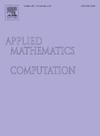A finite difference method with symmetry properties for the high-dimensional Bratu equation
IF 3.4
2区 数学
Q1 MATHEMATICS, APPLIED
引用次数: 0
Abstract
Solving the three-dimensional (3D) Bratu equation is highly challenging due to the presence of multiple and sharp solutions. Research on this equation began in the late 1990s, but there are no satisfactory results to date. To address this issue, we introduce a symmetric finite difference method (SFDM) which embeds the symmetry properties of the solutions into a finite difference method (FDM). This SFDM is primarily used to obtain more accurate solutions and bifurcation diagrams for the 3D Bratu equation. Additionally, we propose modifying the Bratu equation by incorporating a new constraint that facilitates the construction of bifurcation diagrams and simplifies handling the turning points. The proposed method, combined with the use of sparse matrix representation, successfully solves the 3D Bratu equation on grids of up to 3013 points. The results demonstrate that SFDM outperforms all previously employed methods for the 3D Bratu equation. Furthermore, we provide bifurcation diagrams for the 1D, 2D, 4D, and 5D cases, and accurately identify the first turning points in all dimensions. All simulations indicate that the bifurcation diagrams of the Bratu equation on the cube domains closely resemble the well-established behavior on the ball domains described by Joseph and Lundgren [1]. Furthermore, when SFDM is applied to linear stability analysis, it yields the same largest real eigenvalue as the standard FDM despite having fewer equations and variables in the nonlinear system.
具有对称性的高维布拉图方程有限差分法
由于存在多个尖锐解,求解三维(3D)布拉图方程极具挑战性。对该方程的研究始于 20 世纪 90 年代末,但至今仍未取得令人满意的结果。为了解决这个问题,我们引入了一种对称有限差分法(SFDM),它将解的对称性嵌入有限差分法(FDM)中。这种 SFDM 主要用于获得三维布拉图方程更精确的解和分岔图。此外,我们还建议对布拉图方程进行修改,加入一个新的约束条件,以方便构建分岔图并简化转折点的处理。所提出的方法与稀疏矩阵表示法相结合,在多达 3013 个点的网格上成功求解了三维布拉图方程。结果表明,对于三维布拉图方程,SFDM 优于之前采用的所有方法。此外,我们还提供了一维、二维、四维和五维情况下的分岔图,并准确识别了所有维度的第一个转折点。所有模拟都表明,布拉图方程在立方体域上的分岔图与约瑟夫和伦德格伦[1]在球域上描述的成熟行为非常相似。此外,当将 SFDM 应用于线性稳定性分析时,尽管非线性系统中的方程和变量较少,它却能得到与标准 FDM 相同的最大实特征值。
本文章由计算机程序翻译,如有差异,请以英文原文为准。
求助全文
约1分钟内获得全文
求助全文
来源期刊
CiteScore
7.90
自引率
10.00%
发文量
755
审稿时长
36 days
期刊介绍:
Applied Mathematics and Computation addresses work at the interface between applied mathematics, numerical computation, and applications of systems – oriented ideas to the physical, biological, social, and behavioral sciences, and emphasizes papers of a computational nature focusing on new algorithms, their analysis and numerical results.
In addition to presenting research papers, Applied Mathematics and Computation publishes review articles and single–topics issues.

 求助内容:
求助内容: 应助结果提醒方式:
应助结果提醒方式:


